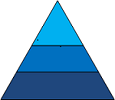Website Design, Land-use Knowledge Network
Design of the LuKN website is based on a number of key principles. As well a number of exemplary sites have provided insights and examples of leading practices.
The key for the LuKN web presence is to focus on ideas and issues. These ideas are selected because they are topical and relevant. Land-use issues encompass environmental, economic as well as social dimensions; land-use issues are multi-dimensional and varied. To reflect this diversity, the LUKN site will need to be continually renewed and updated as new issues are introduced and profiled.
The TED.com website provides one possible design model to support this approach. The TED site features presentations on important ideas. While the LUKN site will include some video presentations it will also feature documents and other media.
While the LuKN site will serve as the home base - a recognized source of information and insights around topical land use issues - it is important to engage with interested users beyond the website in a number of different ways. The site will serve as a destination as well as a disseminator - using a variety of social media to inform users and potential users about content, to solicit ideas and commentary and to encourage active discussions and dialogue around key issues and ideas.
The LuKN site, as with TED, will initially profile issues on the front page. A participant will select an issue and be transferred to a dedicated page focusing on that particular issue; which would also include links to other resources, located on the LuKN site or to external sites. New ideas will be continuously added, older presentations are indexed and then able to be accessed through the navigation links (supported by the content management system and tagging.)
While TED presentations tend to provide an overview and an interesting presentation, the LuKN site will need to be able to support more in-depth information. The LuKN will adopt the concept of the information pyramid.
 The information pyramid is based on the principle of "mass customization" - it is possible to identify various types of user needs and ensure that products and services are customized or modified to reflect these needs. Full customization requires that each customer be provided with a unique response. Mass customization acknowledges that it is possible to identify various user types or categories and respond to their needs. This approach is more efficient and is able to address the needs of most users. The concept of an information pyramid suggests that some users need very brief summaries - short bursts of information that give a quick overview of provide a basic context to an issue. Other users are looking for practical, applicable information - recommendations and guidelines about how to apply information to solve problems. In this case, users are more interested in well developed guidelines and concise lists of possible actions to help them put information into practice. Other users may want to obtain the full details such as a comprehensive report, scientific article, even the actual data and information that was gathered to examine the issue.
The information pyramid is based on the principle of "mass customization" - it is possible to identify various types of user needs and ensure that products and services are customized or modified to reflect these needs. Full customization requires that each customer be provided with a unique response. Mass customization acknowledges that it is possible to identify various user types or categories and respond to their needs. This approach is more efficient and is able to address the needs of most users. The concept of an information pyramid suggests that some users need very brief summaries - short bursts of information that give a quick overview of provide a basic context to an issue. Other users are looking for practical, applicable information - recommendations and guidelines about how to apply information to solve problems. In this case, users are more interested in well developed guidelines and concise lists of possible actions to help them put information into practice. Other users may want to obtain the full details such as a comprehensive report, scientific article, even the actual data and information that was gathered to examine the issue.
The use of the information pyramid allows the LuKN site to do more than provide topical issues. The site also serves as a deep repository for useful information, which is designed to meet the distinct needs of different users. Within the sub-sites (deeper information around specific issues or themes), a number of different types of information sources could be provided, i.e., links to research evidence, best practice repositories, various reports and documents. Some of this information would reside on the LuKN site; many other resources would be through trusted links. A specialized librarian will be involved in search for and identifying key resources that will be integrated into the information pyramid.
The LuKN will be designed to serve as both a source of information as well as a vehicle for interaction. We view the two elements - information/content and interaction/communication-collaboration as being interconnected.
While the content/information resources of the LuKN site are intended to be fully open to the public, the ability to engage in interaction/communication-collaboration will require that participants are registered users. (Registration will be open to anyone.)
The registration function is intended to serve several functions - LuKN will know the registered participants and, as a result, be able to keep them informed (using a variety of social media) about new information and site features; registered participants will be able to search for other participant and experts (using an expert locator tool); and LuKN will be able to offer more customized services to users based on their identified interests and needs. (These services will be developed and introduced in stages.)
As noted, registration allows participants to enter the "value-added" section of the LuKN site. Value added includes allowing various levels of communication and interaction.
The types of interactions that will be supported are based on a natural view of the ways that people communicate and interact with each other. We believe that these interactions can be viewed as a continuum - moving from a minimal investment of time and effort and requiring limited trust levels to more significant engagements of time requiring higher levels of trust and relationship. (Again, it is important to emphasize that these interaction levels will be introduced in stages; and will reflect a "design, pilot, learn, refine" approach to development.)
We are considering the following types of interactions:
- commentary
- questions
- connection
- dialogue
- creation
Each concept is briefly described:
Commentary
Primarily around information resources - allows participants to provide insights and opinions on the information resources (and engage in limited responses to other responses.) Contributions could include suggestions on applications, comments about applicability in different contexts, links to other resources. A like/dislike feature could provide feedback to commentators about their inputs.
Questions
There are several different approaches that can be developed to support questions - participants pose specific questions to the larger community/network with an open invitation for others to respond. As noted, there are a variety of approaches. One consideration is that the LUKN may support a number of sub-networks or communities and, as such, a question and response function may be limited to interactions within the sub-network. As well, there are different levels of facilitation and management of these services. In most cases, a question and answer service would link a FAQ function, the repository would grow over time. One element that would be considered is a way to monitor the currency and value of the various information elements within the FAQ.
Connection
An important part of interaction is to be able to identify who to talk to. There are many different approaches to expert locators, with varying degrees of impact. As participants register for the site, the registration information they provide will provide the basis for an expert/participant database. An expert locator (virtual yellow page) could be developed to allow participants to search the database to find people who may have expertise or insights. [Given the uneven success of many other expert locator initiatives, the development of the connection service will likely be a later stage activity.]
Dialogue
More intensive conversations around issues and questions. Typically, dialogues would involve specific groups or sub-networks. Often dialogues are purposeful - intended to obtain a desired outcome as a result of the conversations. There are different approaches, models and technologies to support dialogues. (It will be important to carefully consider how LuKN will support dialogue initiatives.) Questions for consideration include - the type of interaction (text, voice or video based), real-time or asynchronous; moderated or group managed, etc.
Creation
The final, and likely the most advanced level of communication and collaboration includes creative activities. The ability to engage in rich collaboration to explore issues and make recommendations is an important opportunity for the LuKN. In many cases, the LuKN may be supporting collaborative initiatives of other groups, networks and associations. There are many different tools and technologies that can be used to support collaboration. LuKN will likely link to these offering as oppose to developing a customized approach.






